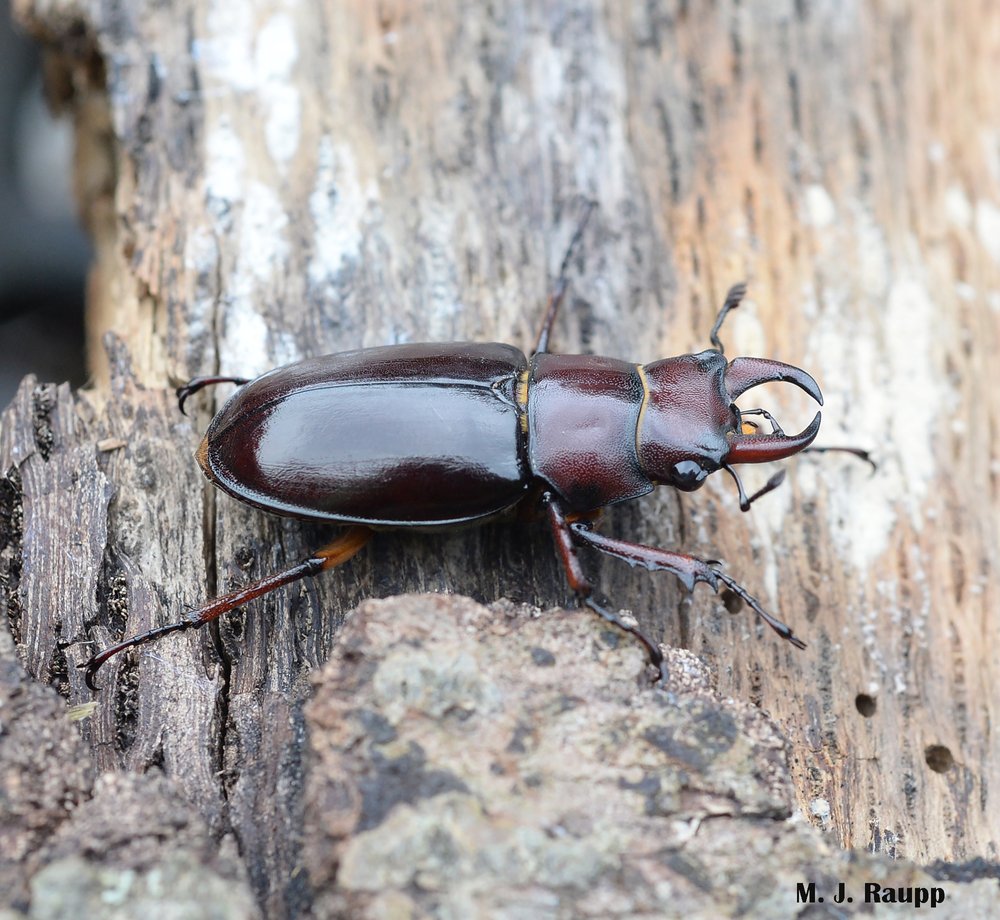
With jaws almost as long as its body, the elephant stag beetle is the largest of its kind in the United States.

Other stag beetles with somewhat less impressive mandibles like this reddish-brown stag beetle also help recycle wood here in the DMV and around the nation.
Last July we met the pleasant reddish-brown stag beetle and learned about the male’s prodigious horns, battle gear used for combat with other male stag beetles to secure access to females and their breeding sites in decaying stumps and rotting wood. This week we meet the giant stag beetle discovered by an avid insect and nature lover in coastal Virginia. The rack on the male giant stag beetle simply dwarfs mandibular ornamentation of other stag beetles here in the DMV and throughout the United States. Stag beetles are relatives of rhinoceros beetles we met in a previous episode. Male rhinoceros beetles, like our indigenous Hercules beetle, also use prodigious horns on their head to battle competitors for access to females. Amazingly large horns on rhinoceros beetles and ridiculously giant jaws of stag beetles may confer a selective advantage in winning the favors of comely female beetles, hence the continued selective pressure for large weaponry.
Stag beetles dwell in damp forest woodlands where females seek moist decaying stumps or decomposing logs, often in low-lying undisturbed forests. Wet decaying wood serves as the favored location for female beetles to deposit eggs. Larvae, aka grubs, hatch from these eggs and develop over a period of one to two years as they consume lignified tissues of their woody hosts. Stag beetle larvae house a rich microbial community in their gut. These symbionts release nutrients locked in tough woody tissues, making these goodies available to support the growth and development of stag beetle grubs. Along with several other species of wood digesting insects, lucanid larvae play a critical role in recycling organic matter in forests around the world. Adult lucanid beetles are reported to dine on fermenting exudates of plants and sweet honeydew excreted by sap-sucking insects. As you will see in the video, they are also very fond of fruit. As a house guest and star of this episode, our elephant stag beetle demonstrated a particular preference for cherries over grapes and bananas. Lucky for us and him that cherries are in season. The important role of these forest recyclers is imperiled as natural forested lands disappear and become housing developments, business parks, or heavily managed landscapes. A close relative of our elephant stag beetle, the charismatic Lucanus cervus, has declined dramatically in some parts of Europe.
Check out the jaws on a male reddish-brown stag beetle. Now look at the jaws on the largest stag beetle in the US, the elephant stag beetle. Wow! Watch as this handsome male explores the trunk of a maple tree. The ginormous mandibles are battle-gear used to combat other males for mating rights to female stag beetles. Before returning this one to the wild, I invited this guy in for a fruity snack. Watch as his tiny mouthparts beneath his jaws lap up juicy liquids. With grapes, bananas, and cherries on the menu, cherries turned out to be the winner. Good choice.

Armament such as gnarly teeth and forks help male stag beetles grapple with other males.
Stag beetles are noisy, somewhat clumsy fliers and they create quite a buzz as they zoom though the forest or zero in on your porch light at nighttime. If you are a bug geek like me, you might just want to hold one of these large stag beetles. Worried about those jaws? Well, my house guest did test his jaws on my index finger and although this resulted in a brief adrenaline rush, his jaws failed to break my skin or inflict any pain. Not recommending that you try this, just saying. Stag beetles have very sticky claws at the tips of their feet which enable them to climb trees and grip tightly to nosy humans. According to the Maryland Biodiversity Project, July is an excellent month to spot these fascinating creatures here in the DMV. Head for the forest to catch a glimpse of these giants of the beetle world.
Watch this amazing National Geographic video to see how stag beetles use their supersized jaws to defeat competitors and gain access to mates: https://www.youtube.com/watch?v=-VWFreC4onI
Acknowledgements
Bug of the Week thanks insect lover Jackie for sharing her handsome stag beetle with us. We consulted these references for this episode: “Stag beetles” by Eric P. Benson, “Divergence in Gut Bacterial Community Structure between Male and Female Stag Beetles Odontolabis fallaciosa (Coleoptera, Lucanidae)” by Xia Wan, Yu Jiang, Yuyan Cao, Binghua Sun and Xingjia Xiang, “Insights into the ecology, genetics and distribution of Lucanus elaphus Fabricius (Coleoptera: Lucanidae), North America's giant stag beetle” by Michael Ulyshen, Louis Zachos, John Stireman, Thomas Sheehan, and Ryan Garrick, and “Distribution of Lucanus elaphus Linnaeus (Coleoptera: Lucanidae) in North America” by C. L. Staines.
No comments:
Post a Comment